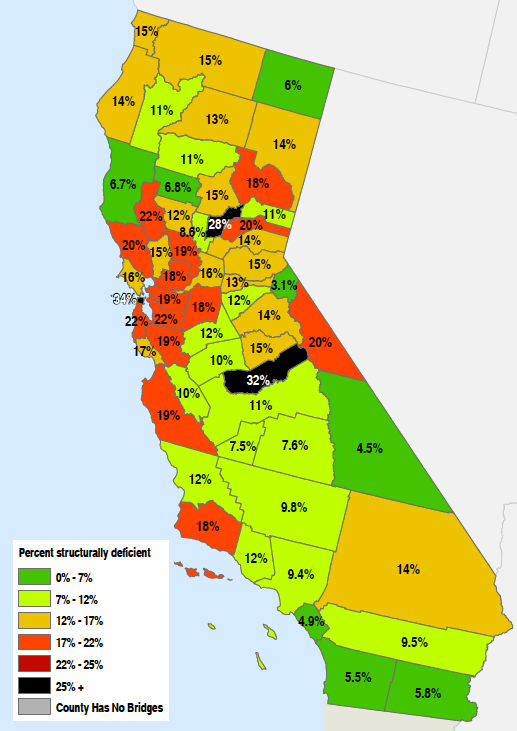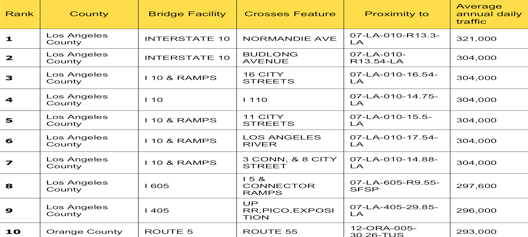Earlier this week, Transportation for America released a report on the state of America's bridges. Capitol Hill Streetsblog broke down those numbers yesterday, but the numbers for California were even worse. According to "The Fix We’re In For: The State of California’s Bridges," 11.8% of California bridges are "structurally deficient" and this figure will continue to rise as an entire generation of bridges approaches their 50-year life expectancy. Additionally the top ten most heavily traveled structurally deficient bridges in the nation are in the greater Los Angeles region.
Transportation for America is using the buzz created by their reports to pressure government leaders to prioritize a "fix-it-first" ethic in to the next federal transportation bill. Local organizer Ryan Wiggins writes, "In the next federal transportation bill we must make caring for our existing infrastructure a core principle. It is key to our public safety and economic security."
But just using federal funds won't be enough for California to address it's growing bridge crisis on its own. To its credit, California already uses all of the federal dollars available for bridge repair for bridge repair. To keep our bridges in a "state of good repair," the highest mark a structure can receive, California officials will need to spend more local and state dollars on bridge repair, maintenance and evaluation. In the 1970's, Governor Brown basically halted highway expansion to support transit. To make sure funding is secured for a "Fix-It-First" campaign of the needed magnitude, highway expansion might need to go back to the back burner.
In addition to the coming crisis as more and more California bridges hit the end of their original life-expectancy, some engineers question whether we even know how bad our crumbling bridge crisis is today.

Marybeth Miceli, the principle of Miceli Infrastructure Consulting, writes:
Structurally deficient referes to three main elements of a bridge:
Ok, you're thinking, that doesn't sound so bad.
The problem comes in that these ratings are subjective and are primarily determined by simply looking at the bridge with you eyes. Imagine if you walked into the doctor for your physical and all he did was take a look at you without performing any other tests. A lot of times this is what we are dealing with. The system is completely broken because we don't use the already limited funding strategically. That is, we don't use the money intelligently to make better bridge management decisions with more advanced technologies than your eyes and some binoculars.
In other words, the problem goes well beyond just the number of bridges that are in bad shape, although that number is too high, but that we don't even know how many bridges are in bad shape. If keeping our bridges, road and rail, in a "state of good repair" is the ultimate goal in California, it's going to require more than money. It's also going to require a new way of looking at things.
(full disclosure: Marybeth Miceli is my wife, but she's quoted here because she's an award winning bridge engineer. I wouldn't quote her about something where she wasn't an expert.)







